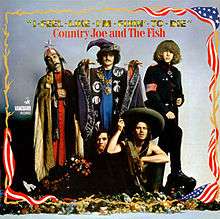I-Feel-Like-I'm-Fixin'-to-Die
| I-Feel-Like-I'm-Fixin'-to-Die | ||||
|---|---|---|---|---|
 | ||||
| Studio album by Country Joe and the Fish | ||||
| Released | November 1967 | |||
| Recorded |
July 1967 – September 1967 Vanguard Studios, 71 West 23rd Street, New York City[1] | |||
| Genre | Psychedelic rock | |||
| Length | 44:56 | |||
| Label | Vanguard VSD 79266 | |||
| Producer | Samuel Charters | |||
| Country Joe and the Fish chronology | ||||
| ||||
| Professional ratings | |
|---|---|
| Review scores | |
| Source | Rating |
| Allmusic | |
| Rolling Stone | (Favorable)[3] |
I-Feel-Like-I'm-Fixin'-to-Die is the second studio album by the influential San Francisco psychedelic rock band, Country Joe and the Fish, and released in 1967. Recordings took place in Vanguard studios in 71 West 23rd Street, New York City.[1] The title track remains one of the most popular Vietnam protest songs from the 1960s and originally appeared on a 1965 7" EP titled Rag Baby: Songs of Opposition. On the album version, "I-Feel-Like-I'm-Fixin'-to-Die Rag" appears following "The Fish Cheer", which at concerts became a Country Joe standard. At Woodstock, Joe had the crowd yell F-U-C-K instead of F-I-S-H. Another musical highlight is the track "Janis" written for McDonald's then girlfriend Janis Joplin. It is the second song written for a female musician for their albums, the other being "Grace". Two singles were released in the wake of the album. These include "Janis"/"Janis (instrumental)" and "Who Am I"/"Thursday".[4]
The second album was released just seven months after the debut and is another prime example of the band's psychedelic experimentation. It again features organ-heavy psychedelia and Eastern melodic lines and more acoustic guitar than their debut production.[5] During this time, the band continued to build on their growing fame by performing at local venues like the Fillmore Auditorium.[6] Despite the familiarity of the opening track, the album itself sold less than the predecessor.[7] The album, as a whole, fit well in the psychedelic scene of San Francisco. The band effectively used satirical humor to express their outspoken views toward the Vietnam War and other hot topics of the counterculture. Although the rest of the tracks were not as popular, they still were accessible and showcased Country Joe McDonald as a lead vocalist. With the creativity of the band reaching a climax, the band began touring nationally and became positively regarded for their live light shows.[8]
The title song faced a legal challenge from the estate of New Orleans jazz trombone pioneer Edward "Kid" Ory, whose daughter Babette claimed that McDonald had appropriated the melody for his song from Ory's classic "Muskrat Ramble" as recorded by Louis Armstrong & his Hot Five in 1926. A 2005 judgment upheld McDonald's copyright on the song, claiming that Ory had waited too long to make the claim.
The original album sleeve contained a poster for "The Fish Game", a huge 22 x 33 inch fold-out board game sheet for throwing a dice and moving five band-member cut-out paper pieces around on. Various goals are available for the game such as "scoring a joint".[7]
Track listing
All songs by Country Joe McDonald, except where noted.
- "The "Fish" Cheer/I-Feel-Like-I'm-Fixin'-to-Die Rag" – 3:44
- "Who Am I" – 4:05
- "Pat's Song" – 5:26
- "Rock Coast Blues" – 3:57
- "Magoo" – 4:44
- "Janis" – 2:36
- "Thought Dream" – 6:39
- "Thursday" (Cohen, Hirsh) – 3:20
- "Eastern Jam" (Bartol, Cohen, Hirsh, Melton) – 4:27
- "Colors for Susan" – 5:58
Personnel
- Country Joe McDonald: vocals, guitar, bells, tambourine
- Barry Melton: vocals, guitar
- David Cohen: guitar, organ
- Bruce Barthol: bass, harmonica
- Gary "Chicken" Hirsh: drums
References
- 1 2 "Country Joe". countryjoe.com. Retrieved March 1, 2015.
- ↑ Allmusic review
- ↑ Vol 1. No. 3, December 14, 1967, p. 19
- ↑ "Feel Like I'm Fixin' for a Comeback". independent.co.uk. Retrieved February 22, 2015.
- ↑ "I Feel Like I'm Fixin' to Die". acerecords.co.uk. Retrieved February 22, 2015.
- ↑ "Billboard Charts". billboard.com. Retrieved March 1, 2015.
- 1 2 James Perone. "Songs From the Vietnam Conflict". Google.com. Retrieved March 1, 2014.
- ↑ "I Feel Like I'm Fixin' to Die". therockasteria.com. Retrieved March 1, 2015.